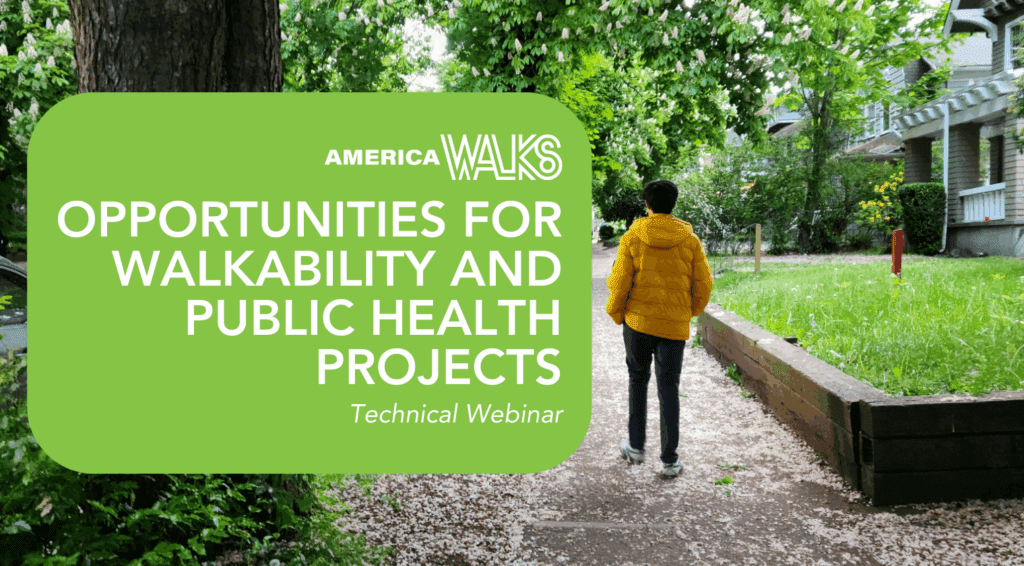We’re often asked, “where can I find funding for my project?” That’s a great question, and the answer is, “it depends!”
Defining Your Walkability Project
If you are looking for funding, you probably have a project in mind. Your starting point is to focus on “the project.” By that, we mean a specific set of investments or improvements with a defined cost and timeline. It can be as simple as a crosswalk or as complicated as a corridor safety redesign. It might be one big project or a series of small projects. Projects are like atoms. They are the fundamental building block of transportation spending, and you’ll need their special attractive properties to bind them to dollars.
If you don’t have a project yet, think about the type of process that might get you started on a project. It could be a volunteer walk audit or a small grant to organize some public process. Defining a project is often a multi-step process, as is building a public coalition to win implementation funds. Planning can come from multiple private or governmental resources, but there are also private sources (see our blog and webinar for details). While it doesn’t take much to get started, transportation project implementation almost always requires government funding. Implementation tends to be at a scale beyond what philanthropy or non-profit granting can fund.
Finding the Money for Your Project
Once you have a project, don’t limit yourself to a specific funding source. States, counties, and cities spend huge amounts annually on transportation, and those dollars far exceed federal dollars for transportation. Most federal dollars sent to states are extremely flexible and can be used for many different purposes. Transportation is also often funded from the general fund, not just from dedicated transportation taxes. So when any government official tells you that they don’t have any money, they are actually telling you that your project is not a priority.
This is not to minimize the challenges faced by state and local governments. The transportation wish list is far larger than their budgets. But all too often, that wish list includes massive roadway expansions straight out of the 1970s interstate highway playbook, despite everything we have learned since then about what communities really need. There’s likely a $1 billion highway or $200 million interchange in the works somewhere when officials say they don’t have $30,000 for a crosswalk. Don’t take no for an answer! Build the kind of public support that will make them reexamine their priorities.
After saying there is no money, state and local government officials may send you to some specialized grant program, many of which are listed below. They’re great, so you should go for it! But remember, if those sources do not come through, state and local governments can still prioritize your project through their other funding sources. If it matters to the community, don’t let them off the hook.
Federal and State Funding Resources
- Pedestrian and Bicycle Funding Opportunities: U.S. Department of Transportation Highway, Transit, and Safety Funds
- Understanding Your State’s Transportation Alternatives Program (TAP) Information Sheet
Non-Governmental Funding Sources
- America Walks Community Change Grants
- AARP Community Challenge
- T-Mobile Hometown Grants (hosted by Main Street America)
- Bike League Community Sparks Grants
- Project for Public Spaces Community Placemaking Grants
- 2025 Ruby Bridges Walk to School Day Mini-Grants
- American Trails’ Trails Capacity Program
Toolkits
- AARP Walk Audit Tool Kit
- Try Before You Buy: How Pop-Up Projects Lead to Big-Time Investments
- Quick Builds & Complete Streets
- Community Connectors Portal: Tools for Advocates
Data
Local Examples
Learn More about Governmental Funding Sources

Download a pre-recorded technical webinar featuring Beth Osborne, Interim President & CEO of Smart Growth America, and Marisa Jones, Managing Director, Policy & Partnerships Director for Safe Routes Partnership, to learn about national and state sources of funding for your community’s walkability project.